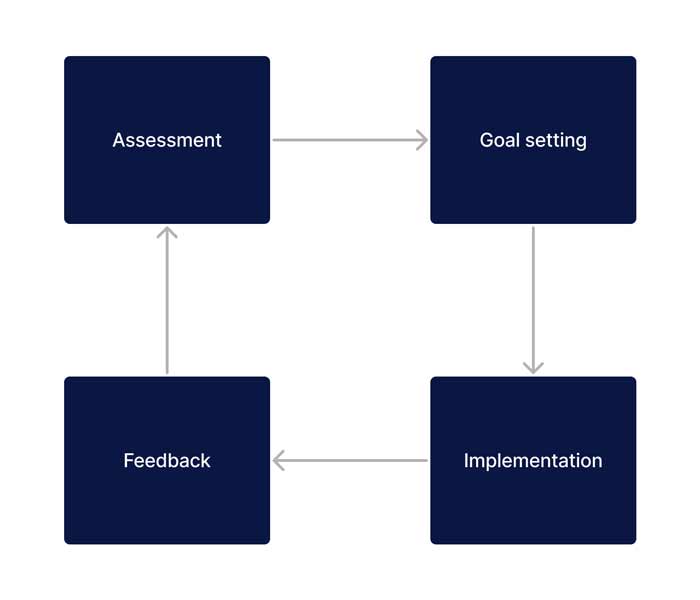What is a Continuous Learning Culture?
A continuous learning culture within a healthcare organisation fosters an environment where learning is not merely a one-off activity but an ingrained habit. It is a culture where staff members, regardless of their role, actively engage in learning to better themselves and improve patient care. Organisations with such cultures implement systems to encourage and facilitate the educational growth of their staff, creating a continuous loop of improvement that enriches both healthcare providers and the patients they serve.
What is Continuous Learning in Healthcare?
Continuous learning in healthcare refers to the ongoing, intentional efforts by healthcare professionals to stay abreast of the latest medical techniques, administrative processes, and technologies.
The dynamic nature of the healthcare environment necessitates continuous learning to meet ever-changing challenges, technological advancements, and patient needs. Furthermore, it enables healthcare providers to comply with the guidelines set by Australian authorities such as the Aged Care Quality and Safety Commission and the Australian Commission on Safety and Quality in Health.
Examples of Continuous Learning Culture
- Regular Training Modules: Periodic training sessions on new medical procedures, technologies, or legislative changes.
- Open Forums: Monthly or bi-monthly meetings for healthcare staff to discuss their experiences, challenges, and learnings.
- Peer Reviews: Frequent peer-to-peer assessments and feedback loops for staff to evaluate and improve performance.

Benefits of Creating a Continuous Learning Culture
The creation of a continuous learning culture brings an array of advantages to healthcare organisations (Chanani, Wibowo, 2019):
| Benefits | Implications |
|---|---|
| Improved Patient Care | With an educated staff, the quality of patient care naturally improves. |
| Higher Employee Satisfaction | Continuous learning opportunities lead to greater job satisfaction and, as a result, lower turnover rates (Lin, Huang, 2021). |
| Operational Efficiency | A learning culture can streamline operations by enabling employees to adopt best practices in all they do. |
How to Identify a Workplace with a Continuous Learning Culture
An organisation with a robust continuous learning culture often shows certain traits, including transparent communication, readily available constructive feedback, and routine updates of procedures in alignment with the latest evidence-based practices.
How to Create a Continuous Learning Culture (Model)
While 'culture' may seem abstract and represents a feeling that people have, a continuous learning culture can be most definitely be be created within healthcare organisations through a systematic way.
Steps to Create a Continuous Learning Culture

- Assessment: Conduct a thorough evaluation of the existing learning culture and infrastructure in your organisation.
- Goal Setting: Set clear and achievable learning objectives for both individual roles and the organisation as a whole (van Breda-Verdujin, Heijiboer, 2016).
- Implementation: Leverage a blend of learning mediums, such as seminars, online modules, and practical workshops, to drive learning.
- Feedback Mechanisms: Set up systems for gathering feedback on the effectiveness of training programmes.
Strategies to Use for Creating a Continuous Learning Culture
Tips for Creating a Continuous Learning Culture
- Engage Leadership: Secure commitment from top management to lead by example.
- Allocate Resources: Invest in high-quality educational materials and training facilitators.
- Measure Impact: Regularly evaluate the effectiveness of learning initiatives through key performance indicators and feedback mechanisms.
- Adapt and Iterate: Be prepared to modify the learning culture strategy as you measure its impact, ensuring continuous improvement.
Tools to Create a Continuous Learning Culture
Creating a continuous learning culture is not just about intentions and strategies; it’s also about leveraging the right tools. The following tools can effectively aid healthcare organisations in building a robust learning culture:
- Learning Management Systems (LMS): A robust LMS can serve as the backbone for any learning initiative, enabling the organisation to create, manage, and track various learning modules.
- Performance Management Software: Tools for performance management allow for regular evaluations, which can help in identifying learning opportunities.
- Collaboration Platforms: Tools like Microsoft Teams or Slack can facilitate real-time communication and sharing of educational materials amongst healthcare staff.
- Mobile Learning Apps: These allow healthcare professionals to learn on-the-go, making continuous learning more accessible.
- Feedback Tools: Feedback mechanisms within these tools can provide valuable insights into the effectiveness of learning modules and strategies.
How Ausmed Can Help Create a Continuous Learning Culture in Your Organisation
Ausmed has a number of solutions that can help develop and nurture a continuous learning culture within your healthcare organisation:
- The Ausmed LMS is a solution you can use to enhance your organisation's continuous learning culture.
- The Ausmed Library has Over 1000+ learning activities available on key practice areas to enhance your staff's learning and development
- The Ausmed LMS can assign learning resources to staff which they can access on the Ausmed App!
- The Ausmed Passport fast-tracks mandatory training for aged care organisations, allowing more time for skills development beyong meeting compliance.
How to Evaluate My Workplace's Continuous Learning Culture?
Evaluation is crucial for the sustainability of a continuous learning culture. Utilise quantitative and qualitative metrics, like employee engagement surveys, performance metrics, and patient outcome data, to measure the effectiveness of your continuous learning initiatives. Tools such as Learning Management Systems can be highly effective for this purpose.
Are There Negatives to Creating a Continuous Learning Culture?
While generally beneficial, a focus on continuous learning can sometimes lead to training fatigue or information overload, particularly if not implemented thoughtfully. Therefore, balancing learning initiatives with the demands of day-to-day work responsibilities is crucial for avoiding these pitfalls.
Interested in developing a learning culture in your organisation?
Contact Ausmed today and see how we can support your organisation develop and nurture a continuous learning culture!
Additional Resources
- How Can Organisations Create a Learning Culture that Attracts Amazing People?
- Communicating the Value of Learning in Healthcare
- LMS in Healthcare: The Roles, Benefits and Pros and Cons
Conclusion
Creating a continuous learning culture in healthcare organisations is not merely beneficial; it is essential in the fast-paced healthcare landscape of today. Such a culture enriches healthcare professionals with the knowledge and skills they need to excel in their roles, thereby providing an elevated level of patient care. The key to success lies in mindful implementation, regular evaluation, and a willingness to adapt your learning strategies to meet evolving needs.
References
- Aged Care Quality and Safety Commission. (2021). Aged Care Quality Standards. Retrieved from https://www.agedcarequality.gov.au/providers/standards
- Learning culture, continuous learning, organizational learning anthropologist (2016). Retrieved from Emerald Insight
- A Learning Culture and Continuous Learning for a Learning Organization (2019). Retrieved from Knowlege E
- Employee turnover intentions and job performance from a planned change: the effects of an organizational learning culture and job satisfaction (2019). Retrieved from Emerald Insight



